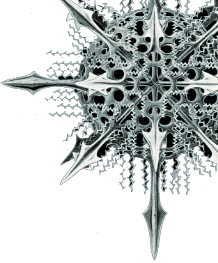VARIETY
PROTEUS by Scott Foundas
Man's dream of uniting nature and art forms the subject of Proteus, a stimulating scientific inquiry that may cause audiences to look at (and think about) the world around them in dramatically different terms. The first feature-length work by documentary and avant-garde filmmaker David Lebrun, one-of-a-kind pic, reportedly some two decades in the making, should become a sought-after item on the fest circuit and for experimental film showcases. Tube sales should also be brisk, though Lebrun's majestic, laboriously hand-crafted images more than deserve the splendor of the big screen.
Pic begins as an ostensibly straightforward investigation into the life and work of 19th century artist and biologist Ernst Haeckel, whose major work, Art Forms in Nature, synthesized his two disparate passions by presenting lithographs of some 4,000 species of previously unidentified single-celled sea creatures called radiolarian. Haeckel did both the identification and the lithography.
Haeckel's story becomes the jumping-off point for a series of fecund associations in which Lebrun establishes connective tissue between Haeckel and such unlikely compatriots as Sigmund Freud and Vladimir Lenin, the architects of the first transatlantic telegraph cable and the fictional title character of Samuel Taylor Coleridge's Rime of the Ancient Mariner (beautifully voiced by Richard Dysart).
It's a very dense amount of material to pack into an hour of screentime, but Lebrun manages to make it seem effortless, never moving too fast for non-science types to keep up. In the end, Lebrun keeps bringing it all back, dazzlingly, to Haeckel.
Like his subject's own work, Proteus (pic appropriately takes its name from the shape-shifting Greek god of the sea) does not merely represent a casual interest in a subject. Rather, what gives the film its propulsive strength is the sense that Lebrun has fully given himself over to Haeckel, allowing himself to become consumed to the point of near-obsession.
Particular energy has been spent on finding the ideal way to convey Haeckel's unique images in a distinctly cinematic vessel. Proteus is a constant visual treat, as Lebrun takes photographs of Haeckel's actual drawings and animates them in ways that make Haeckel's splendiferous orbs and tentacles dance in an array of carefully choreographed patterns. (Technique recalls what Thom Andersen did with the photographs of Muybridge in his 1974 Eadwaerd Muybridge, Zoopraxographer.)
In the end, Lebrun makes auds contemplate the majestic vastness of the natural universe and its complex artistic perfection in ways that even Haeckel could only have imagined.



